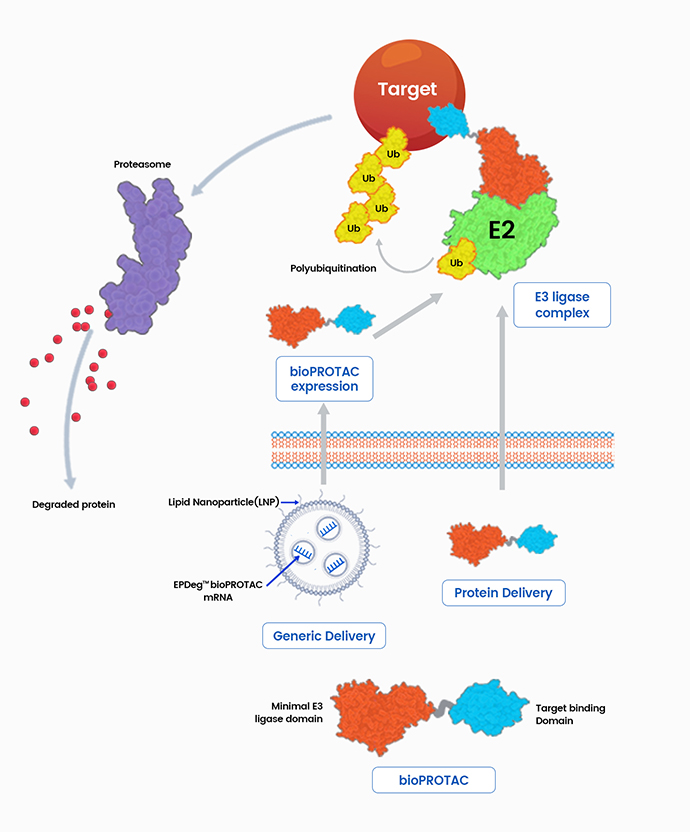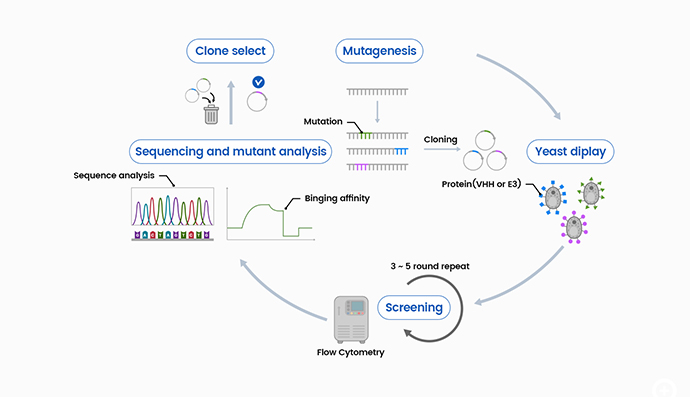bioPROTACNext Generation PROTAC with Biologics
Our challenge
for a healthier and happier life
for humanity continues.
bioPROTAC's mechanism of action
EPDeg™: bioPROTAC Platform Technology
EPDeg™ bioPROTAC is composed of a target binder (nanobody) and a modified E3 protein as a form of direct fusion protein between the two, providing the following advantages.

- 1Capable of degrading the most undruggable targets which cannot be targeted by small molecules
- 2No need to use a linker of small molecule-based PROTAC which expedites the process of lead candidate selection
- 3No need to find a binder to E3 proteins which enables us to utilize all existing human E3 proteins & Capable of enhancing the target protein degradation efficacy by engineering E3 proteins
With the aim of overcoming small molecule-based PROTAC, EPDBio develops a next-generation of targeted protein degraders, bioPROTAC, termed as EPDeg™ (Engineered Protein Degraders).
bioPROTAC: A next-generation of targeted protein degraders utilizing biologics (ex. antibody fragment, peptide, etc.) as a selective binder to the protein of interest
| EPDeg™ vs. | Main advantage of EPDeg™ bioPROTAC(proved by data) |
|---|---|
| PROTAC |
Possible to degrade novel targets that cannot be degraded by small-molecule based PROTAC at this moment & There is no need to have the linker used in PROTAC synthesis → We proved that EPDeg™ bioPROTAC can potently degrade currently intractable targets by PROTAC (ex. SOX2, ATXN1) |
|
Possible to show higher potency by utilizing new E3 ligases that cannot be recruited by small molecule E3 ligands at this moment → We proved that EPDeg™ bioPROTAC can have much higher potency than PROTAC for the same target (ex. STAT3) |
|
| siRNA / ASO | Much higher level of down-regulation and much faster therapeutic effects were observed with the use of EPDeg™ bioPROTAC |
| Other bioPROTACs | Possible to improve TPD efficiency by using EPD’s own engineered E3 proteins We proved substantially enhanced STAT3 degradation when one of engineered E3s was used to generate EPDeg™ |
bioPROTAC has superiority over knock-down approach by siRNA or shRNA as following.
| siRNA / shRNA | bioPROTAC | |
|---|---|---|
| Target selectivity | Off-target knock down often reported (2D sequence-based selectivity) | Potentially lower off-target effect (3D structure-based selectivity) |
| Subpopulation specific effect | Subpopulation specific knock down possible |
Subpopulation specific degradation possible
|
| Kinetics | Impossible to degrade target protein that was already created before drug injection. If the protein has a long half-life and is stable, it may take a long time for the drug effect to be observed. |
Able to degrade target proteins that have already been generated before drug injection. The drug effect can be expected in a faster time. |
| Applicability to aggregated proteins | Not applicable to insoluble protein aggregates observed in degenerative brain diseases | Applicable to insoluble protein aggregates |
Nanobody and E3 Protein Engineering Technology
- 1Utilization of a yeast display system optimized for engineering: Compared to phage display, it increases the potential for bioPROTAC development through optimization of post-translational modifications (PTM) and protein folding.
- 2Simultaneous improvement of protein expression levels and thermal stability.
- 3Rapid and precise variant screening technology: Real-time variant screening is possible using a sorter with an optimized protocol.

